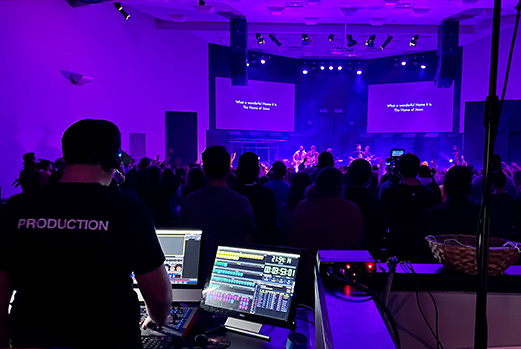Every Sunday morning, before the first chord is played or the first lyric appears on the screen, someone is behind the computer making it all happen. Church media volunteers might not be standing on stage, but their role is every bit as vital to helping the congregation worship. The words, scriptures, and visuals they display create connection, clarity, and focus for everyone in the room.
But as any tech leader knows, training someone new to handle presentation software for churches can feel like a big task. Maybe your volunteer has never worked with media tools before. Maybe they’re comfortable with computers but nervous about serving in front of people. Whatever the case, with a thoughtful approach and the right mindset, you can turn anyone with a willing heart into a confident and capable operator.
Here’s how to do it.
1. Start with the Heart, Not the Hardware
Before showing volunteers how to advance slides or trigger videos, help them understand why their role matters. What happens on the screen isn’t just decoration—it’s part of worship. When lyrics are clear and timed well, it helps people sing freely. When scripture and sermon points appear at the right moment, it keeps attention centered on God’s Word.
Framing the role as ministry, not “just tech,” gives volunteers purpose. They’re not running a computer; they’re serving the congregation. That mindset makes all the difference in how they approach Sunday mornings.
2. Keep It Manageable at First
New volunteers don’t need to know every feature on day one. Start small and build up.
Begin with the basics—opening the service Script, advancing Cues, and checking the order of service. Once they feel comfortable with those core actions, introduce more advanced features like background management, scripture lookups, or inserting new media.
By breaking the learning curve into smaller pieces, you reduce overwhelm and set them up for success. A few short, hands-on sessions are usually more effective than one long crash course.
3. Practice in Real Environments
The best training happens during real or simulated services. Have new volunteers sit in during rehearsals or low-pressure midweek events so they can experience what it’s like to run slides in time with music and transitions.
Timing is one of the most important parts of using presentation software for churches. Volunteers learn quickly when they can see how a song feels in motion, when to advance lyrics, or how to handle an unexpected pause. Encourage them to practice following along silently at first, then take over advancing slides once they feel ready.
And when possible, let them “drive” the presentation during a real Sunday—perhaps starting with a smaller segment of the service like announcements or a single song set. Experience is the best teacher.
4. Write Down Your Workflow
Every church develops its own rhythm and preferences over time. Maybe your pastor likes scripture verses to appear one line at a time. Maybe your team uses color-coded folders or has a specific naming system for Cues.
Document all of that in a short reference guide. Include steps for opening the program, loading the Script, adjusting backgrounds, and troubleshooting common issues. Keep it simple—just a one-page quick-start sheet that anyone can reference when they get stuck.
This not only reduces mistakes but also makes onboarding new volunteers in the future much easier.
5. Teach Grace as Much as Technique
Mistakes will happen. A lyric might appear late, or the wrong slide might flash up. When it does, stay calm—and help your volunteers stay calm too. Encourage them to focus on recovering smoothly rather than panicking.
Church media is a ministry of service, not perfection. What people remember most isn’t the one missed slide—it’s the heart and attitude behind the booth. Remind your volunteers that the goal is worship, not flawless production.

6. Use Training Resources That Do the Work for You
When it does come to the technical training aspect, you don’t have to do it all yourself. It can make a huge difference to employ resources like the MediaShout Plus Membership, where the MediaShout experts handle the training for you. Whether it’s one-on-one calls, remote desktop help, or video sessions for your entire team, your volunteers can get personal, practical instruction that fits your schedule.
If your team prefers to learn at their own pace, Plus Membership also includes on-demand video resources that volunteers can log in and access anytime. It’s like having a built-in tech coach who knows church presentation inside and out.

7. Build a Team Culture
Running presentation software for churches should never feel like a lonely job. Foster a sense of teamwork among your volunteers. Encourage them to pray together before services, share tips, and support each other. Rotate responsibilities occasionally so no one burns out.
And most importantly, celebrate them! Mention their contributions in meetings, thank them from the stage, or bring in coffee and donuts once in a while. Recognition goes a long way toward keeping your team motivated and engaged.
Training volunteers to use presentation software for churches is one of the most rewarding investments you can make in your ministry. When your team feels prepared, confident, and supported, they’ll not only run slides—they’ll help create an atmosphere of worship where technology serves the message beautifully.














